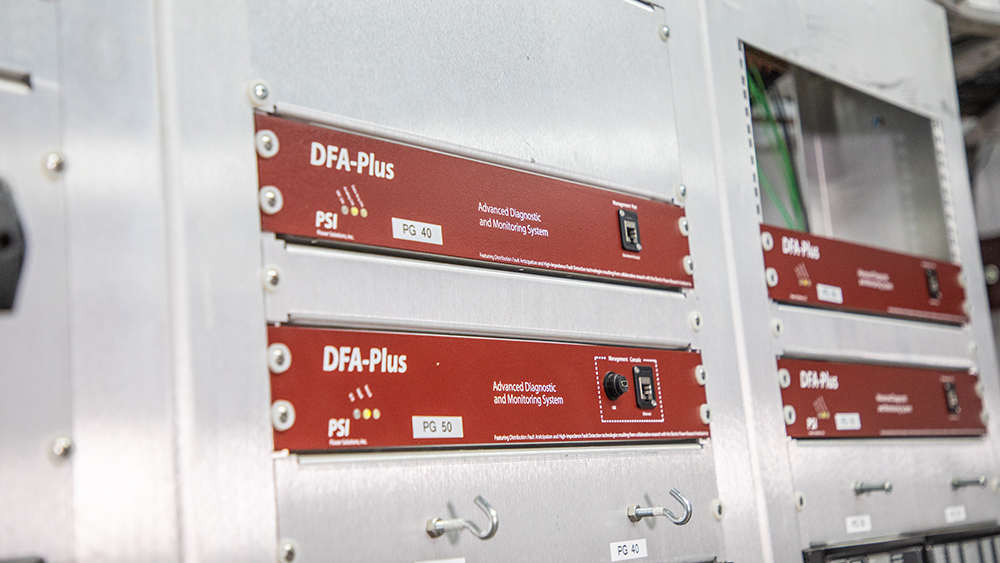
Utilities can keep the lights on, prevent fires with new diagnostic tool
Interest is spreading across the globe in a new technology developed at Texas A&M University to help electric utilities keep the lights on and prevent horrific wildfires.
It’s a one-of-a kind hardware and software system called Distribution Fault Anticipation (DFA). It can diagnose problems on utility lines before outages darken neighborhoods, before power failures spark wildfires or before fears of wildfires prompt massive, preemptive power outages.
DFA interprets variations in electrical currents on utility circuits caused by the deteriorating equipment. It warns utility operators to respond to particular problems before they cause outages and possibly spark fires.
Electric power companies have nothing else like it.
‘A game changer’
Engineers at Texas A&M developed DFA over 20 years of research and testing at more than a dozen utilities across the nation, including Texas utilities such as Pedernales Electric Cooperative, Mid-South Synergy and Bluebonnet Electric Cooperative.
DFA is now being tested by two of California’s biggest utilities, Pacific Gas & Electric and Southern California Edison, where utilities have been linked to some of the most destructive wildfires ever. Texas A&M researchers also are working on tests with utilities in New Zealand, the United Kingdom and Australia.
The Texas A&M research team is led by Dr. B. Don Russell, Distinguished Professor of Electrical and Computer Engineering, and research professor Carl L. Benner.
Due to the widespread interest in preventing wildfires, Russell testified in December before the U.S. Senate Energy and Natural Resources Committee to explain the technology’s advantages.
Afterward, Sen. Angus King of Maine described DFA as “dramatic and important.” Sen. Catherine Cortez Masto of Nevada called the technology “a game changer.”
Like your ‘Check Engine’ light
Russell and Benner liken DFA to the computer-based diagnostic tools found in modern cars, ones that warn when fluids are running dry or that an engine part is close to failure.
“Utility systems operate today like my 1950s Chevy,” Russell said. “They have some fuses and breakers and things, but they really don’t have anything diagnostic. They don’t have that computer under the hood telling them what’s about to go wrong.”
Electrical power outages commonly are caused by falling trees that tear down lines or failures of devices such as clamps, switches, conductors and connectors.
The devices can deteriorate over weeks or months, impacting electrical currents in small ways before actual failures — perhaps triggered by high winds. DFA continuously monitors currents and applies its algorithms to detect and report abnormalities for investigation and repair.
Until now, utility companies have had little choice but to wait and react to failures, electrical equipment is durable and deterioration of devices is difficult to see. That makes visual inspection and preventive maintenance only marginally helpful.
Utilities representatives have long recognized that something new is needed, given the nation’s aging infrastructure. DFA answers this need.
4,000 Texas wildfires
Texas A&M engineers developed DFA to help utility companies improve reliability in general, but they also saw its potential for preventing some wildfires.
Early research funding came from the Electric Power Research Institute, a nationwide group of utility companies and other industry stakeholders. In recent years, the state of Texas funded DFA testing in response to wildfires in 2011.
More than 4,000 Texas wildfires were caused by power lines in 2009, 2010 and 2011, the Texas A&M Forest Service found. The largest was the deadly Bastrop fire in 2011, which started when winds shook some Loblolly pine trees into electric lines in the area served by the Bluebonnet Electric Cooperative.
Bluebonnet is among several Texas utilities that have kept using DFA after the four-year test period. Thomas Ellis, manager of engineering, said Bluebonnet is expanding its use of DFA beyond areas most prone to wildfires.
“DFA has provided greater insight into our system health,” Ellis said. “It allows us to be proactive in equipment repair and replacement.”
Keeping the lights on
Not only does DFA improve reliability and help prevent fires, it could potentially give California utilities a tool to limit preemptive power outages such as those endured by millions of Californians last fall. The utilities turned off the lights based only on dry conditions and weather forecasts.
“Utilities need a crystal ball, something telling them which circuit is going to start a fire tomorrow because it is already unhealthy,” Russell said. “DFA is kind of a crystal ball.”